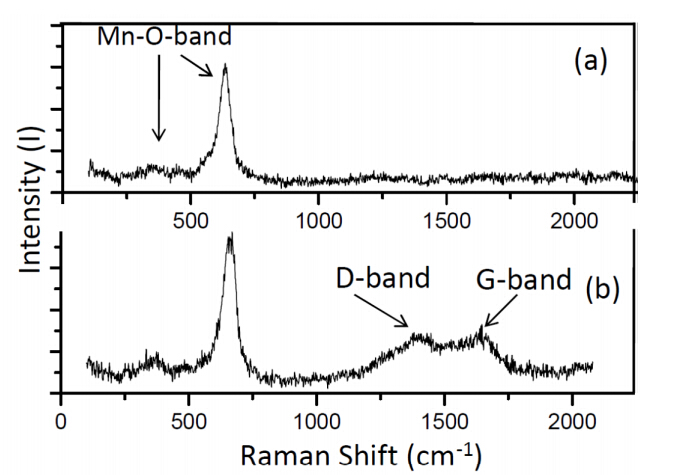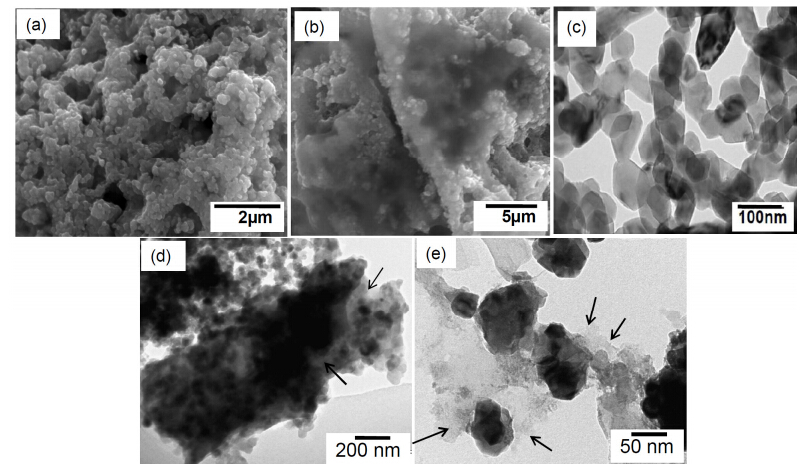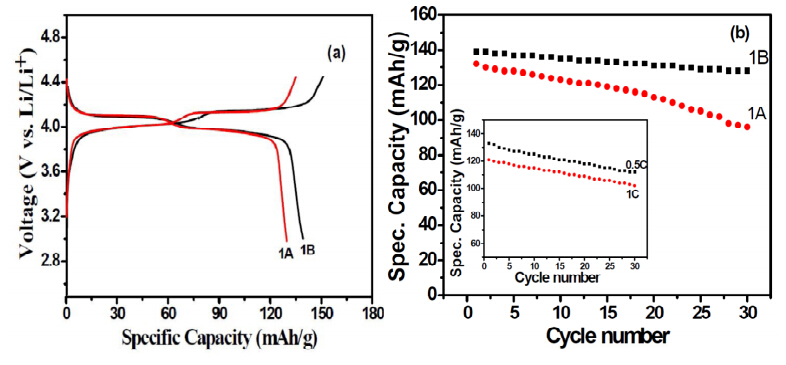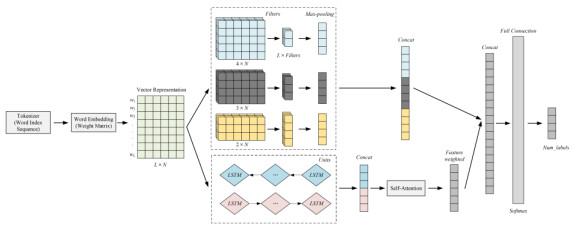1. Introduction
Metal oxide based materials have been intensively studied as electrode materials for Lithium ion batteries (LIBs), to achieve higher specific capacities than the traditional electrode materials [1]. Among these, the spinel structure based LiMn2O4 is considered as one of the potential materials that has replaced the more expensive and toxic layered transition metal oxides such as LiCoO2, LiNiO2, LiNi1/3Co1/3Mn1/3O2 etc. [2, 3, 4].
Recently, this has been well marked as one of the cathodes for energy storage system ranging from portable electronic devices to vehicular applications such as EV, HEV, P-HEV’s and aerospace application [5]. The LiMn2O4 is an attractive cathode material for LIB’s due to the high voltage, good capacity, abundance of manganese, low cost and environmental benignity. However, this material suffers with poor conductivity and structural instability during charge-discharge process, which is due to the volume expansion and Jahn-Teller distortion [6, 7]; dissolution of Mn2+ into the electrolyte [8]; and capacity loss [9]. It is highly desirable to overcome these problems to make this LiMn2O4 meet the requirement of cathode material that is suitable for vehicular application. One way is to dope LiMn2O4 with different transition metal cations such as Cr, Ni, Al, Co, Fe, Mg,
etc. [10, 11]. Doping diminishes the dissolution of Mn2+ from the LiMn2O4 structure and suppresses the Jahn-Teller distortion [12]. In addition, partial double doping of two transition metals into the structure will have synergic effect on the cyclability [13].
The LiMn2O4 compound has been obtained by various methods such as co-precipitation [14], ball milling [15], sol-gel [16], microwave [17], spray pyrolysis [18] and so on. All these methods produce LiMn2O4 with small particle size. Unfortunately, the nano sized particles prepared by these methods suffer from poor electrical conductivity and strong agglomeration of particles. Sometimes small impurities were also observed, which require high calcinations temperature of about 800 °C to remove those impurities [20, 21]. Recently, some researchers deposited the metal oxide on carbon nanotube or reduced graphene oxide to avoid the agglomeration of particles and obtained metal oxide-graphene hybrid electrode [22, 23]. Bak et al. prepared LiMn2O4 reduced graphene hybrid using microwave assisted hydrothermal or solvothermal reaction [24]. Combustion method is another synthesis route that yields finely divided phase pure particles using cheap inorganic reactants (nitrates) and organic fuels (urea, citric acid, glycine, PAA, etc., ) [19, 20, 21].
In this paper, we report preparation of the LiMn2O4 graphene hybrid cathode material using modified spray drying combustion processes followed by heat treatment. The spray drying method has advantages of producing homogeneous single crystal nanosize particles. Therefore, combustion and spray drying processes was used for deposition or coating of graphene sheets on the LiMn2O4. This facilitate have graphene coated nanoparticles. Addition of graphene decreases the dissolution of Mn into the electrolyte and controls volume expansion on charging-discharging process. The porous nature and nanosize of the LiMn2O4 graphene hybrid shows better electrochemical properties than the pristine LiMn2O4 sample.
2. Experimental
2.1. Preparation
The stoichiometric amount of raw materials, LiNO3 and Mn (NO3).4H2O, which act as oxidising agents and sucrose as reducing agent and fuel, were dissolved in minimum amount of DI water. The atomic ratio of Mn/Li is set to be 2:1 and oxidiser to fuel ratio 1:1 [25]. The beaker containing solution was placed on a hot plate at a temperature of 200 °C. After several minutes the combustion process was completed with the evolution of large volumes of gases (N2, H2O, CO, NHCO), leaving behind a black powder. The powder was then divided into two parts named hereafter as 1A and 1B. The reduced graphene oxide was prepared by modified Hummer’s method [26]. The 1B precursor was mixed with 5 wt% of reduced graphene suspension and spray dried on a hot plate at 120 °C temperature to obtain LiMn2O4 graphene hybrid nanocomposite. Then, the obtained 1A and 1B sample powders were ground and calcined initially at 350 °C for 2 hours and then finally at 700 °C in air for 1 hour.
2.2. Characterization
The structure and phase purity of the samples were analysed by Cu-Kά (λ = 1.5418 Aº (in 2θ) ) radiation of X-ray diffraction (XRD, Bruker D8-advance, Germany) in the range of 10-70°. The thermal decomposition behaviour of the synthesized nano powder was examined with a thermo-gravimetric analyzer (TG-DSC) on a Netzch (Luxx, sTA, 449, Jupiter, Germany) analyzer under N2 flow. The TGA spectra were acquired in the temperature range from 30-1000 ºC at a heating rate of 10 ºC min-1. Raman spectra were recorded using Raman spectrometer (Horiba Jobin-Yvon Labtam HR 800) to confirm the formation of LiMn2O4 graphene hybrid nanocomposite. The morphology and particle size were observed by Field Emission-Scanning Electron Microscopy (FE-SEM; Hitachi’s, S-4300 SE/N) and Transmission Electron Microscopy (HR-TEM; Tecnai G-20, 200 KeV) working at 200 KeV.
The electrochemical performance of the samples was investigated by assembling Swagelok cell with Lithium foil as reference and counter electrode. The positive electrodes were prepared from both samples 1 A and 1B (80 wt%), a mixture of 5 wt% super P carbon and 5 wt% graphite, and polyvinylidene fluoride (PVDF, 10 wt%) was dissolved in N-methyl pyrrolidone. All the components were mixed to form slurry to coat on stainless steel foil current collector and the coated foils were dried in an oven at 100 °C for 12 hours. The electrolyte used was 1M LiPF6 in a mixture of ethylene carbonate (EC) and dimethyl carbonate (DME) with mass ratio of 1:1 and Whattman glass filter paper film was used as separator. The cells were assembled into Swagelok cells within an Argon-filled glove box. Glavanostatic charge-discharge measurement were conducted on an Arbin battery system at different current densities in the voltage range of 3.0-4.5 V (versus Li/Li+).
3. Results and Discussion
The thermogravimetric curves of LiMn2O4 graphene hybrid sample prepared by combustion and spray drying before heat treatment is presented in Figure 1. The results show two steps of weight loss, which corresponds to temperature range of 80-150 ºC, and 280-400 ºC. The first weight loss step below 150 oC is due to the volatilization of the absorbed water and other organic substances, which corresponds to few endothermic peaks in the DSC curves. The second weight loss between 200-400 oC is due to the crystallization of LiMn2O4 phase and corresponds to exothermic peak in the region 300-400 oC [20]. The DSC curves observed are similar to other combustion based LiMn2O4 sample reported in literature [19, 20, 21]. The total weight loss during the whole heating process is less than 10%. This indicates that most of the precursor material is converted to amorphous LiMn2O4 state during the combustion process, which forms crystalline state upon heat treatment.
Figure 2 displays the XRD patterns of pristine LiMn2O4 and LiMn2O4 graphene hybrid samples obtained by combustion and spray drying followed by heat treatment at 700 °C. The diffraction patterns of both samples are similar. These patterns correspond to a well-defined single phase LiMn2O4 peaks that can be indexed to cubic spinel structure of Fd3m space group. This is in good accordance with the st and ard pattern (JCPDS, card no.04-013-6575). The lattice parameters calculated from the diffraction data through the least square program are found to bea = 8.24726 Å and cell volume is 560.96 ų, which is closest to the st and ard value reported in literature [27]. For the LiMn2O4 graphene sample, the characteristic peak of graphene at 2Ɵ = 26.5 °C was not detected probably due to the small quantity of the graphene used and the strong diffraction signals from the spinel LiMn2O4 phase. As the crystallinity plays a crucial role on electrochemical performance, a calcination temperature of above 800 °C is considered to be essential for good cyclic performance of the oxide cathode materials [28]. In previous reports, a calcination temperature above 800 oC was required to obtain pure LiMn2O4 phase by solution or combustion based synthesis [19, 20, 21]. However, in present study, the samples calcined at 700 °C completely transformed into cubic spinel structure of Fd3m space group, in which the Lithium ions occupy the tetrahedral sites (8a), Mn3+ and Mn4+ ions reside at the octahedral sites (16d), and O2- ions are located at 32e sites [29].
The Raman spectra of the both the samples were measured in order to confirm presence of graphene and the formation of LiMn2O4 graphene hybrid composite and spectra is shown in Figure 3. The presence of a strong b and at around 650 cm-1 and a group of b and s between 200 and 500 cm-1 with lower intensity are common features of this spectra. These b and s are attributed to the vibrational motion of oxygen atoms inside the octahedral MnO6 unit [30]. The presence of Mn-O b and s confirms that the sample has a spinel structure. The Raman spectrum of LiMn2O4 graphene sample suggests that the Mn-O b and s are marginally shifted to higher frequencies than the pristine LiMn2O4 nanoparticles. There are two b and s observed at around 1336 and 1570 cm-1 for LiMn2O4 graphene sample, which can be attributed to the D-b and and G-b and of graphene, respectively. The D-b and represents the sp3 structural disorder due mainly to defects in the graphene sheets, whereas G-b and reflects the structural integrity of the sp2-hybridized graphene sheets [31, 32].
The size and morphology of the heat treated samples were observed using FE-SEM and TEM analysis. It was found that the sample prepared by combustion process shows porous morphology as shown in Figure 4 (a). The typical images of spray dried coated LiMn2O4-graphene hybrid sample is shown in Figure 4 (b). It can be observed that small LiMn2O4 particles were coated with graphene sheet. These small particles formed porous agglomerate particles, which is good for Li ion battery application as the electrolyte can be accessed through this porous structure. Figure 4c represents TEM images of pristine LiMn2O4 particles with size about 60nm. The images in the Figure 4d and e show the TEM images of LiMn2O4 graphene samples. Two types of graphene and LiMn2O4 coating were observed from the TEM images. In Figure 4d, we can observe that LiMn2O4 nanoparticles were deposited on the surface of graphene sheets, which is indicated by arrow mark. Whereas, in Figure 4e the LiMn2O4 nanoparticles wrapped up with graphene sheets can be observed. This sample shows hexagonal and bipyramidal shaped particles with size in the range of 50-60 nm. The LiMn2O4 nanoparticles with small particle size and good graphene coating on the particle surface are suitable for high capacity cathode materials.
Figure 5a shows the initial charge-discharge profile at room temperature (25 °C) of LiMn2O4/Li cell, voltage applied between 3.0 and 4.5 V for pristine LiMn2O4 and LiMn2O4 graphene. It was observed that two distinct plateaus appeared on the charge curve as well as on the discharge curve for both the cathodes as shown in Figure 5a, respectively. From the charge and discharge curves, it was also observed that graphene coated LiMn2O4 (1B) had a slightly higher initial discharge capacity (139 mA h/g) than that of pristine LiMn2O4 (1A) (132 mA h/g) at 0.1C rate. This slight increase in capacity of LiMn2O4-graphene sample can be attributed to the improved conductivity of the sample due to graphene wrapping on the LiMn2O4 and the fact that Li+-Li+ coulombic repulsion is lower at the surface of nanomaterials enhancing local Li capacity because there is no neighbouring Li+ outside the particle [33].
Figure 5b shows the discharge capacity vs. the cycle number plots of pristine LiMn2O4 and LiMn2O4-graphene cells at room temperature (25 °C) for the first 30 cycles. The LiMn2O4 graphene cells deliver a discharge capacity of 139, 133 and 121 mAh/g at 0.1, 0.5 and 1 C, respectively, at initial cycle. At the end of 30 cycles the capacity retention is about 87, 85 and 84% at 0.1, 0.5 and at 1 C respectively. The capacity retention of LiMn2O4 graphene hybrid is about 92% of theoretical capacity at 0.1 C, when compared to pristine samples, which show only 73% after 30 cycles. This indicates that the hybrid sample shows about 20% higher capacity retention that can be attributed to the fact that the LiMn2O4 nanocrystals are either deposited on the conductive graphene sheets as observed in the Figure 4d or wrapped by graphene sheets as in Figure 4e. The graphene coating on the particle avoids the direct contact of particles with electrolyte, therefore, the dissolution of Mn could be prevented. In addition, it also reduces the Jahn-Teller distortion and decreases the volume expansion. These results are better than the previous reports, where about 30-40% capacity loss was common after the initial discharge cycles [26]. Thus, the LiMn2O4 graphene hybrid material with h igh crystallinity shows improved electrochemical cycling performance compared with pristine LiMn2O4.
4. Conclusion
LiMn2O4 graphene hybrid cathode has been synthesized by a two-step process. The amorphous LiMn2O4 obtained by combustion process was spray dried with reduced graphene on hot plate at 120 °C followed by heat treatment at 700 °C for 1 hour. The results reveal that both pristine LiMn2O4 and LiMn2O4 graphene samples have well-ordered crystallinity and high phase purity. The FE-SEM and TEM images show that the 60 nm (approx.) sized LiMn2O4 particles are either deposited on the graphene sheets or wrapped by the same resulting in hybrid material. The LiMn2O4-graphene sample exhibits a high initial capacity of 139 mAh/g, which is about 94% theoretical capacity at a discharge rate of 0.1C than that of the pristine LiMn2O4 (132 mAh/g). It also exhibits good rate capabilities of 133 and 121 mAh/g at 0.5 and 1C, respectively, and show about 20% higher capacity retention in 30 cycles than the pristine sample.
Acknowledgement
The authors acknowledge Dr. Y. Srinivas Rao (Centre for Ceramic, ARCI) and Mr. L. Venkatesh for the TG and DSC and FESEM measurements. Thanks are also due to Akki Bhasker (IIT Hyderabad) for helping in the electrochemical measurement.









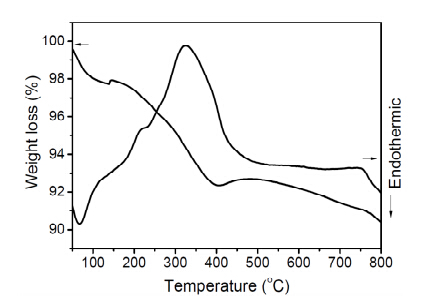
 DownLoad:
DownLoad: 
